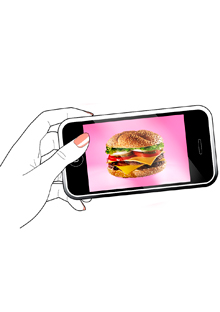3 New Tricks to Lose Weight
By Sari Harrar

Illustration: Jason Lee
Can your cell phone help you shed pounds? New research says yes. Sari Harrar reports on three subtle—and surprising—strategies for achieving your ideal weight.
Ever heard of the twilight zone diet? It's the one where you swear you're doing everything right but still can't drop a pound. Part of the problem may be that your intentions don't match your actions: Recent Cornell University research found that people tend to underestimate the calories they're eating by as much as 38 percent. And they exaggerate how much exercise they get, overestimating calorie burn by as much as 62 percent, according to a University of Texas study. Add these findings together, and you could be 100 percent stuck.But researchers are finding new ways to help you get back to reality. With the following strategies, you can start winning at the losing game.
Strategy 1: Turn Every Meal (and Snack) into a Photo Shoot
Strategy 2: Beat the "Weekend Effect"
Strategy 3: Track Every Step, Measure Every Calorie
Photo: © 2009 Jupiterimages Corporation
Turn Every Meal (and Snack) into a Photo Shoot
When 43 women and men agreed to photograph every morsel before they ate it for one week (and keep a written food diary as well), researchers at the University of Wisconsin–Madison found the results eye-opening—and diet-changing. The mealtime shutterbugs, all of whom considered themselves healthy eaters, discovered that their portions were too big, their meals bereft of fruit and vegetables, and their snack choices calorie-laden. Rather than continue to photograph their bad choices, many chose to eat something else instead.
"The act of taking a photo made them so much more aware of what they were eating," says lead researcher Lydia Zepeda, PhD, a professor of consumer science at the university. "They weren't trying to lose weight, but many said they didn't want an unhealthy snack or a second helping at a meal if they had to take a picture of it."
Though the success of keeping written food diaries is well documented (they doubled weight loss in a recent study from the Kaiser Permanente Center for Health Research), Zepeda theorized that a photo diary might be even more motivational. "With a written diary, there is nothing you do in the moment. You eat the food and write it down later," she says. "With a photo diary, you can still change your mind and choose fruit over cake."
Or as one study volunteer said, "Who wants to take a photo of a jumbo bag of M&Ms?"
Zepeda's group used film cameras, but she recommends going digital—the camera in your cell phone may be the simplest option, and you'll have images to look at immediately. To get a handle on what you're eating, take a picture of everything you consume over the course of an entire day, she suggests. "Don't change anything. Choose the foods you would normally eat so you can see your eating habits," Zepeda says. Then continue to snap for at least a week as you improve your diet. (If you're concerned about your food choices, Zepeda recommends reviewing your photos with a registered dietitian.) And anytime your weight loss plateaus, bring out the camera again.
Beat the "Weekend Effect"
Everyone needs a break. But relax your diet and exercise efforts too much on the weekend and you could offset the hard work you put in Monday through Friday, report researchers from the Washington University School of Medicine in St. Louis.
Susan B. Racette, PhD, assistant professor of physical therapy and medicine at the university and the lead study author, documented this phenomenon by carefully tracking the weight, eating habits, and physical activity levels of 48 women and men before and during her 12-month diet and exercise study. Participants kept food diaries (they weighed and measured everything they ate), weighed themselves on laboratory-grade scales every morning, and wore monitors equipped with sensors to measure physical activity.
The results surprised Racette: Before the study began, volunteers were eating enough additional calories each weekend—compared with their weekday regimen—to result in a gain of 9 pounds in a year.
Once the study started, participants who were supposed to be following a reduced-calorie diet had a steady weight dip from Monday through Thursday. But beginning on Friday, they simply stopped losing weight. The study also had an exercise-only group, and these people actually gained weight.
The reason for the gain was that on Saturday and Sunday, nearly everyone cheated a little—eating an extra 100 to 300 calories a day, mostly from higher-fat foods. And while physical activity increased on Saturdays, it was lower than average on Sundays.
"We thought weekends would present a problem for some people, but it was actually a problem for almost everyone—and these were motivated people who knew they were being watched closely," Racette says.
The good news is that the gain each weekend was, on average, less than half a pound, the kind of small increase that only becomes a problem over months. Preventing the gain should be easy, Racette says, provided you plan for it. "Set aside some time for a walk on Sunday," she says. "Eat before you leave the house to run errands so you don't end up at the drive-through or the mall food court. Bring snacks if you're going to sit at a child's soccer game all day so you don't buy nachos from the snack stand."
Track Every Step, Measure Every Calorie
Keeping tabs on all the calories your body burns—at rest, working out, and living life—used to mean joining a research study, becoming a Biggest Loser contestant (they wear calorie monitors on their arms), or shelling out big bucks for a high-tech, bulky armband.
No longer. GoWear Fit, a sleek monitor, tracks motion, steps, sweat, skin temperature, and heat flux from your muscles, then calculates the input with an equation that takes into account your age, gender, height, weight, and other personal details to reveal your daily calorie expenditure. Worn on your upper arm, the nifty device collects data that you download to your computer via a USB cable, and the data is whisked to a password-protected webpage that displays your calorie information, total daily activity, total daily steps (from running or walking), and sleep time. Manufactured by BodyMedia—the same company that makes the Bodybugg, used by Biggest Loser contestants—the armband costs $199 plus monthly online costs ranging from $7 to $13. For on-the-spot feedback, a $99 display you wear on your wrist will track your data in real time.
Exercise researcher Stephen Yang, PhD, an assistant professor of physical education at State University of New York College at Cortland, says this innovative armband takes the guesswork out of one side of the weight loss equation. "Until recently, mainly research labs used devices that measured calorie burn this way," he says. "Seeing the numbers can be a real motivator and will help keep you from missing workouts." Use the GoWear Fit to figure out how much additional activity you need to burn an extra 500 calories a day. If you keep up that effort, you should drop about a pound a week.
Sari Harrar is a health and science writer living in Pennsylvania.
Related Resources


















No comments:
Post a Comment